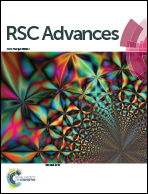Enhancement in luminescence properties of ZrO2:Dy3+ under 100 MeV swift Ni7+ ion irradiation†
Abstract
ZrO2:Dy3+ samples are synthesized by a combustion technique. The XRD results of ZrO2:Dy3+ (1 mol%) reveal a monoclinic phase with an average crystallite size of ∼30 nm. FESEM images show spherical nanoparticles with a diameter of ∼60 nm. Luminescence properties are analyzed as a function of the Dy3+ concentration. The ZrO2:Dy3+ samples exhibit PL emission at 489 nm and 589 nm, corresponding to 4F9/2 → 6H15/2 and 4F9/2 → 6H13/2 transitions under an excitation of 353 nm. The most favorable PL emission corresponds to a Dy3+ concentration of 1 mol%. Furthermore, pellets of ZrO2:Dy3+ (1 mol%) are irradiated with 100 MeV swift Ni7+ ions in the fluence range of 3 × 1010 to 1 × 1013 ions per cm2. Blue (489 nm) and yellow (589 nm) PL emission intensities increase with the increase in ion fluence up to 3 × 1012 ions per cm2, and beyond this fluence, the PL intensity decreases with further increases in the ion fluence. The blue to yellow transition ratio increases with ion fluence, which indicates that the Ni ion induced defects modify the material from lower to higher symmetry. TL glow curves of the undoped ZrO2 exhibit a well resolved glow at 424 K, and an unresolved one at 550 K. ZrO2:Dy3+ (1 mol%) exhibits a broad TL glow with a peak centered at 480 K. This glow peak intensity increases with an increase in ion fluence, up to 1 × 1013 ions per cm2. TL kinetic parameters are calculated by computerized curve deconvolution analysis (CCDA). The presented results show that ZrO2:Dy3+ phosphors may be tested for TL dosimetry applications.



 Please wait while we load your content...
Please wait while we load your content...